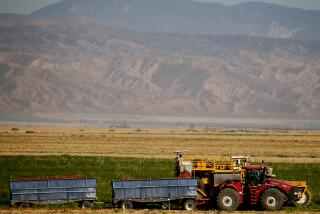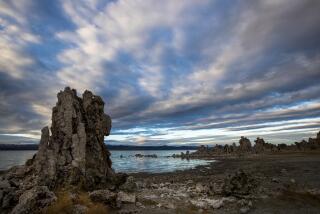Tiny mountain community finally gives up its old-school water district
- Share via
LOMPICO, Calif. — In the mountains north of Santa Cruz, water is managed, as they say, “the old-school” way.
Bills are written out every two months and volunteers stuff envelopes at mailing parties. Chlorine levels are checked by hand and well pressure is calculated by a 21-year-old who got the job responding to a newspaper ad.
Residents fought for years to hang on to this way of life. But last year, state health officials announced that the Lompico County Water District’s drinking supply was one of the “most vulnerable” in California. Then a pump broke on one of the community’s aging wells, cutting off a major source of water. And with so little rain, the creek slowed to a gurgle.
Now, after four years of drought, Lompicans have accepted that it’s time to get out of the water business.
Last winter, residents agreed to have the neighboring San Lorenzo Valley Water District take over their mom-and-pop operation. First, though, residents have to figure out how 494 households will come up with $2.75 million to upgrade the infrastructure.
It would be the latest of several water annexations in recent years in this area’s mountain communities — and a glimpse of what state officials say is the future for California’s smallest water districts. At least 18 districts have been consolidated since 2013, according to the State Water Resources Control Board.
The idea of merging had come up before, “like 20 years ago, and people said no, no, no,” said Merrie Schaller, a Lompico resident and water board director, “because it’s cool to have your own water district.”
Founded in the 1920s after the logging era, Lompico is now home to Silicon Valley commuters as well as longtime residents who open conversations by touting the number of years they have lived here. Many point up the road to Janis Joplin’s old hangouts and say that Jerry Garcia’s middle finger, chopped off accidentally before his Grateful Dead days, is still around somewhere.
For decades, managing Lompico’s water was simple. There are three wells, Lompico Creek and a network of tanks and pipes that bring fresh water to sinks and showers. In addition to the cost of the water, homeowners paid about $50 each month for a handful of staff to keep the system running.
The state’s warning last year fueled rumors that Lompico was running out of water. The real problem, Schaller said, is outdated infrastructure to deliver the water.
Unlike most districts today, which use steel tanks, Lompico still stores its water in ones made from redwood trees. One of the tanks is leaking “so bad that you could basically save water by taking a shower underneath it,” Schaller joked.
For Aidan Robinson and Ricardo Villa, two of Lompico’s three water system operators, most mornings begin with a trek uphill in a 1995 Toyota Tacoma that could give out at any moment. The $15,000 they had saved up for a less taped-together truck instead had to be spent fixing a well.
One recent morning, Robinson turned on a pump to refill two tanks that deliver water to homes. Farther up the unpaved road, Villa determined that water levels in the tanks had dropped almost 2 feet overnight.
Robinson quickly calculated that they would need to keep the pump running for 40 minutes.
“Everything’s manual. Our automation is fried,” Robinson said. “Our problem isn’t water, it’s money.”
Talk of merging with San Lorenzo Valley began in 2010, when board members came to realize that revenue from fewer than 500 customers was not enough to sustain the aging system.
The San Lorenzo Valley district, which surrounds Lompico, saw benefits to merging but did not want to inherit its broken infrastructure. Lompico would be a good place to store more water, general manager Brian Lee said, and folding Lompico Creek into the district’s system of eight streams would make water management more efficient.
Lompico residents, having long cherished their water independence, were wary. Conspiracy theories abounded, and the cost made it a hard sell. Each household will probably pay an extra $6,000 over 10 years to fund infrastructure upgrades.
But after years of meetings, most came to understand the need to modernize.
“We have to bring this system back up to snuff,” said Sean Wharton, who has lived for more than 45 years in the cabin built by his great-grandparents. “There are necessary changes that people have to make for us to have water into the next generation.”
NEWSLETTER: Get the day’s top headlines from Times Editor Davan Maharaj >>
Like many drought-conscious residents, Wharton has been careful with water. At one point, he was down to 13 gallons a day. (In Los Angeles, the average is 77 gallons.)
“We conserve to the point of ridiculousness,” Schaller said. But having residents use less water also means less revenue to pay for repairs.
It’s like you can’t win, Schaller said, adding, “It makes sense to go regional.”
To get a sense of what’s coming, Lompicans could look three miles down the road. Olympia Mutual Water Co., which once pumped spring water to 51 homes, recently was folded into the San Lorenzo Valley district.
Ward Willats, the last resident to oversee his tiny community’s water, said his neighbors have gone through the “stages of denial, anger, acceptance, grief.”
After more than 60 years of the community’s self-sufficiency, state officials kept raising water quality requirements, and the volunteer-run district couldn’t keep up, Willats said.
“Despite the romantic notion of a band of scrappy neighbors getting together and running their own water system … there were some impractical parts of it that weren’t so great either,” Willats said.
New pipes, wireless water meters and other infrastructure — costing almost $1 million — were installed to link up to San Lorenzo Valley’s system. Residents will pay about $500 more a year until they clear the debt.
The spring is now abandoned. The Sunday water operations meetings, where neighbors would meet and become friends, are no more. Residents wax nostalgic for their spring water, which Willats said tasted “a little sweet.” For months, he kept a bottle of it on his kitchen counter.
The water pressure is better, Willats acknowledged, and the new fire hydrants are a relief. Years ago, a fire engulfed the home next door, he recalled. Neighbors rushed out with garden hoses, but by the time the firetruck came back with more water from a nearby district, the house had burned down.
“The San Lorenzo water guys are pretty good,” Willats said. “There was a lot of mistrust at first, but they were very honest and direct and helpful, and it was mostly a win-win situation.”
Back in Lompico, in the crowded bungalow that serves as water headquarters, Schaller answered one phone call after another — a board member volunteering as fill-in secretary.
Robinson and Villa imagined how their jobs might change, wondering if the day might come when they could check water meters with their smartphones.
The mail arrived. One envelope, handwritten, stated its destination in two words: “Lompico Water.” Robinson handed it to Schaller, who began to process the bill.
Twitter: @RosannaXia
ALSO
Younger immigrants in U.S. illegally try to live without parents’ fears
Why Southern California fires are the most deadly and do the most economic damage
Gov. Jerry Brown vetoes off-hours use of carpool lanes on two L.A. freeways
More to Read
Sign up for Essential California
The most important California stories and recommendations in your inbox every morning.
You may occasionally receive promotional content from the Los Angeles Times.










